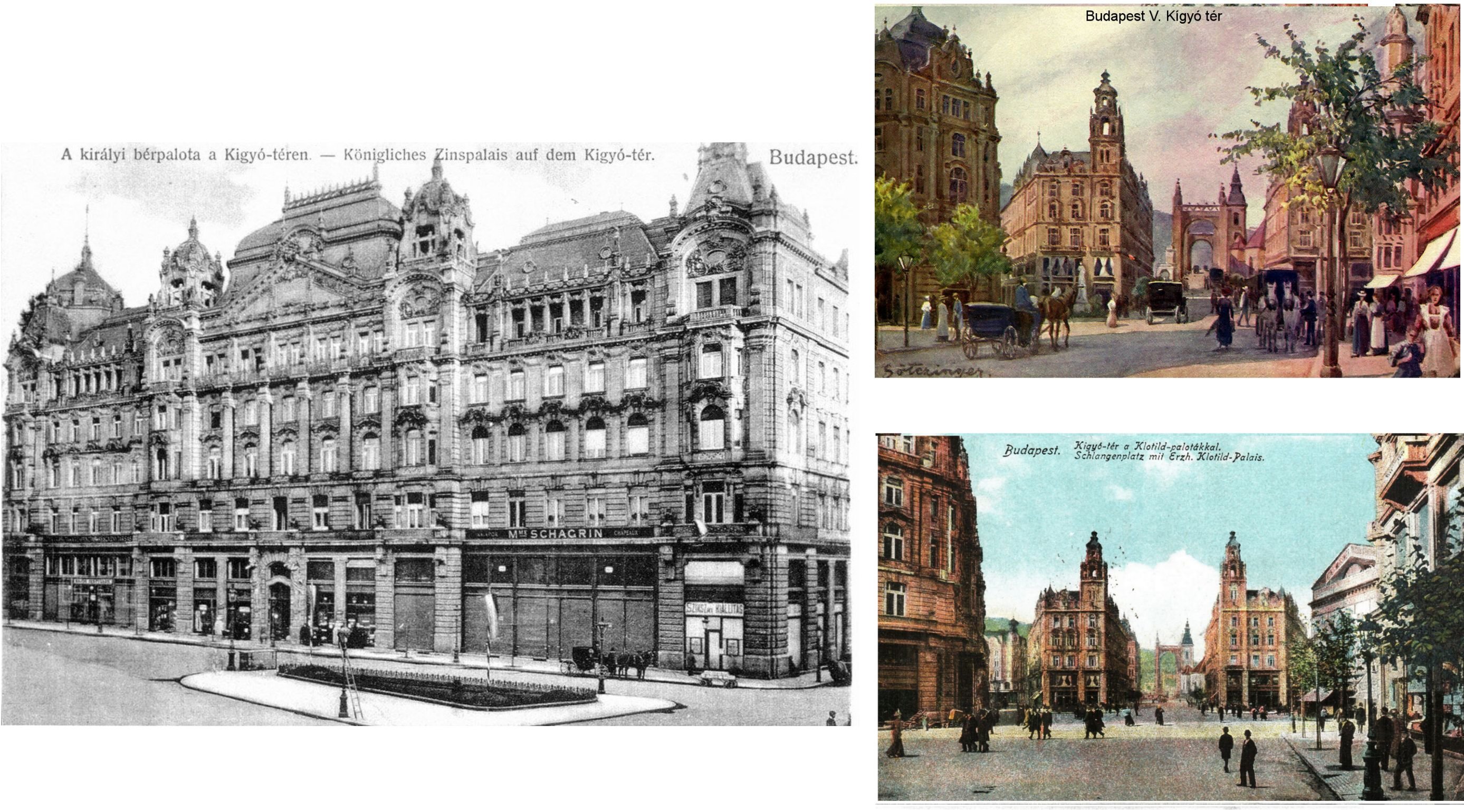
REPORTS FROM EARLY CONTINENTAL EUROPEAN CAT SHOWS - HUNGARY (1902 BUDAPEST SHOW)
1902 BUDAPEST INTERNATIONAL CAT SHOW
December 4-9, 1902 International Cat Show, Budapest, Kiraly Berpalota (Kígyó tér 1.) -
(Many thanks to Szentes Gerzson Peter (www.hazimacska.hu) for finding this article and adding commentary)

Vasarnapi Ujsag (Sunday Mail), November 23, 1902.
"The dog fair was held only once in Budapest, but dog exhibitions have been organized several times, and now they are preparing for an international cat exhibition. This has long been customary in major cities abroad, and in Budapest there will be a cat exhibition from December 4 to 9 in the king's palace apartments (Kigyó-tér 1. no. 16) in business premises. There have been similar exhibitions in Paris, London, Berlin, Hamburg, Dresden, Munich and Prague. Domestic cats of all colours, as well as Manx, Siamese, Persian, Ginster [Genet], American and Chinese cats, half-breed Angora, giant [heaviest], Algerian and African masked Angora cats can be registered for the exhibition. At the close of the show, prizes will be awarded based on breed purity and various useful traits. Gold, silver, bronze medals and certificates are awarded as prizes.
The most striking was the Ginster cat [Common Genet] from the Atlas Mountains [Algeria], with its beautiful striped fur and extremely long tail; however, his small, elongated head could have been thought of as something of a weasel. He was the opposite of the Isle of Man cat snoozing next door, which tends to be tailless.”
Szentes Gerzson Peter: The above lines were published in the November 23, 1902 issue of the Budapest Vasárnapi Ujsag. The news advertised the first Hungarian cat exhibition held in Budapest between December 4 and 9, 1902. The newspapers of the time wrote about this strange event several times in the following weeks. Among the domestic exhibitors' cats, the snow-white animals of the pet dealer Gizella Jakabffy and the two-coloured domestic cat of Martonne Gyula stand out. The rarer specimens of the cats on display were insured for a large sum with a Parisian company. The exhibition was a unique exhibition, as there were no active cat associations in the country at that time, so it was organized by zoologist Jozsef Flesch from Munich on a foreign model. The contemporary drawings of the exhibition also show that many people were curious about this special event, which was never repeated. No cat club was founded, and no more exhibitions were held for many decades. The event itself was soon forgotten, world wars and world crises came. (The next cat show was organized only in 1975, and in the following years, cat exhibitions came with reviews.)

Vasarnapi Ujsag. Translation of cutting:
“Cat exhibition in Budapest. The Munich association that protects and breeds cats organized a cat exhibition in Budapest. You wouldn't believe it, the first cat exhibition in Budapest, in the Kigyo-ter royal apartment building, opened on December 4th amid thousands of interested people. The most beautiful specimens of various cat species are arranged in a long row of cages grouped by species. The domestic cats of the Hungarian exhibitors are beautiful, but the most numerous and most beautiful specimens in the exhibition are from Bavaria. Unusual examples are the Isle of Man part-tailed cat, the Maltese cat, the blue-eyed, deaf angora cat, and the Asian bicolour and tricolour angoras. One of the interesting features of the exhibition is the dark grey Algiers cat, Bumserl from Munich, which is the winner of the London Grand Prix. Dodo, a red-brown, wonderfully developed specimen, won a prize of five thousand francs at the Paris exhibition. The senior of the exhibition is a thirty-two-year-old red-brown Angora, still very lively. There are also some blue-eyed, short-haired specimens from the Siamese king's palace cats. The snow-white animals of pet dealer Gizella Jakabffy and the two-coloured domestic cat of Martonne Gyula stand out among the cats of domestic exhibitors. The exhibition, which will remain open until the ninth of this month, was organized by Jozsef Flesch, a zoologist from Munich. The rarer specimens of the exhibited animals are insured for a large sum at a Parisian company.”
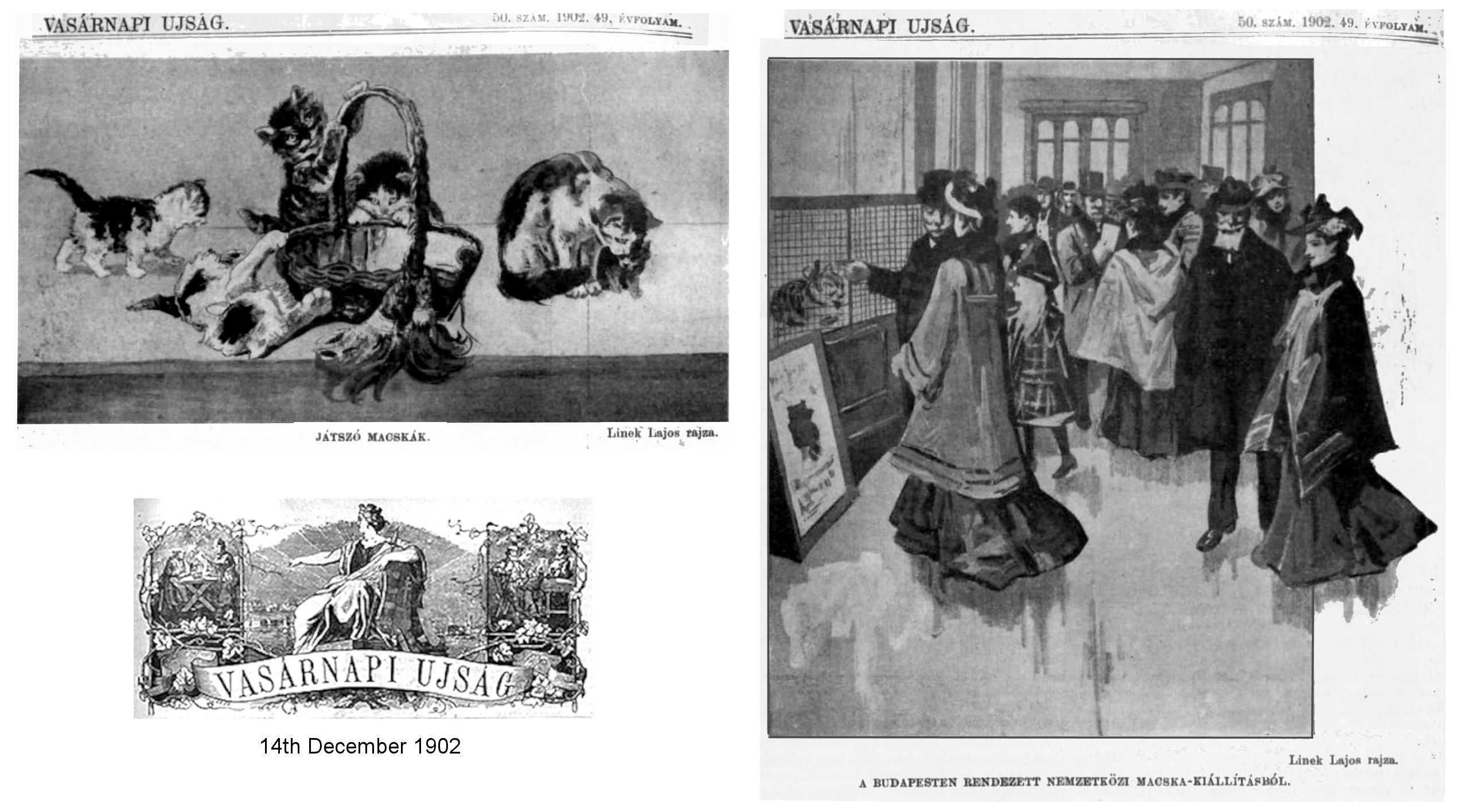
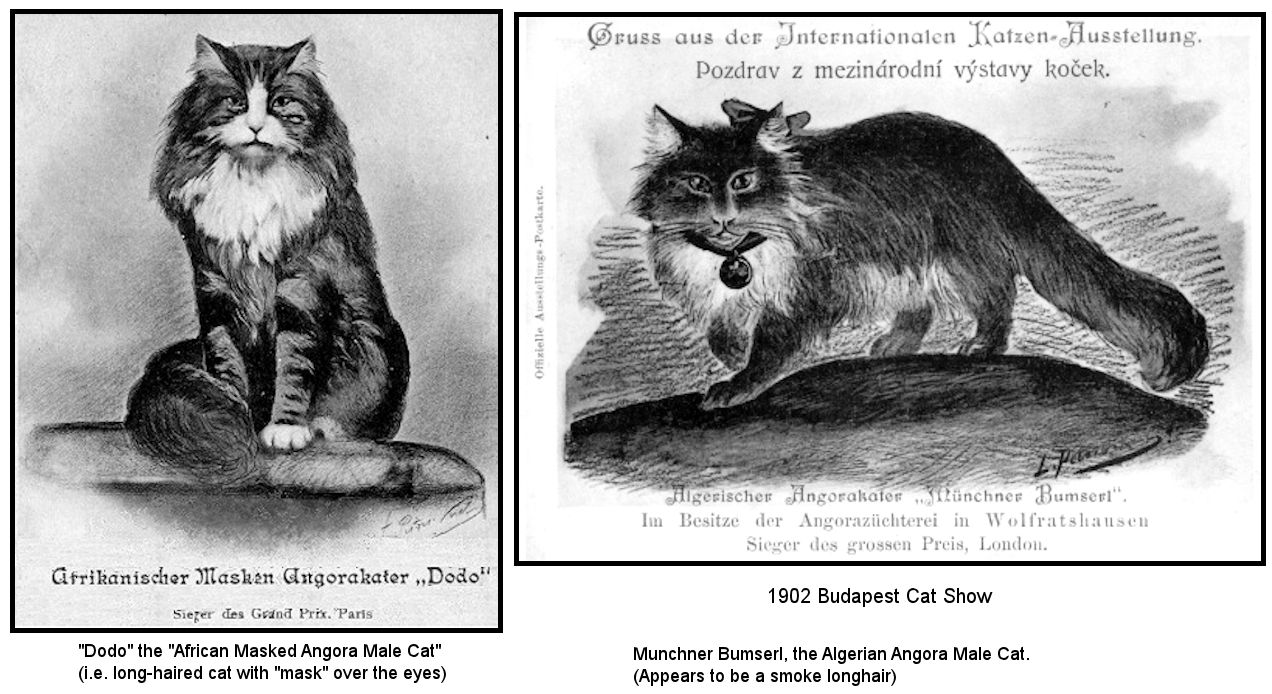
PESTER LLOYD, FREITAG, 5 DEZEMBER:
(Katzenaustellung.) In einem Paterrelokale des Zinshauses des Königs auf dem Kigyo-tér wurde heute eine Katzenausstellung eröffnet – die erste ihrer Art in Ungarn. Während im Auslande die Katze sich besonderer Wertschätzung erfreut, ist bei uns der Hund Trumpf, die Katze wird vollständig vernachlässigt, was sie sich mit Resignation, die jedoch von Koketterie nicht frei ist, gefallen laßt. Indessen die Besucher der Katzenausstellung werden auf ihre Kosten kommen. Die Katze gewinnt bei näherem Berkehr mit ihr. Exklusiv von Natur, vermöge ihrer ganzen Weltanschauung nur dannn dem Berkehr mit Menschen zugänglich, wenn sie die Ueberzeugung gewinnt, daß man sich persönlich um sie bemüht, hat sie so gar nichts von der Unterwürsigkeit des Hundes an sich, welcher die Hand lecht, die ihn schlägt. Haß vergilt sie mit Haß; Gleichgiltigkeit mit Gleichgiltigkeit und Liebe mit aufrichtiger Liebe, was immer auch die Leute sagen, die eine Katze streichelten und dafür gelegentlich mit einem Hiebe ihrer messerscharfen Kralle bedacht wurden. Dies bedeutet keineswegs einen Akt der Feindseligkeit, sondern bildet blos den Ausdruck der Laune, welche, wie bei allen geistvollen Thieren, bei der Katze leicht wechselt. Das Temperament der Katzen kann man freilich bei der jetzigen internationalen Austellung – veranstaltet vom Bund für Katzenschutz, Zucht und Pflege in München veranstaltet – nicht studieren, da die Katze eben wenig Neigung zur Bethätigung im öffentlichen Leben besitzt.
Ungleich dem bemegten und lauten Leben bei Hunde-Expositionen, wo sich diese wakeren Vierfüßler nach der gewissen Ballotage, die aber nur eine Formalität ist, ohne Unterscheid des Standes umd der Race zu lauter, zwangloser Konversation vereinen und selbst den fremden Besucher mit ungesuchter Herzlichkeit empfangen, geht es bei der Katzenaustellung gar stille zu. Ohne von einander Notz zu nehmen, ruhen sie in ihren Kästigen, meist mit geschlossenen Augen, die sie bei längerem Schmeicheln halb öffnen, dem Störenfried zublinzelnd und dann, ohne weiter von ihm Notiz zu nehmen, wieder schließen. Nähert sich jedoch die Eigenthümerin dem Käfig, dann ist das Thier vollständig verändert. Mit Augen, aus denen Freude blitzt, schleicht es sich an das Gitter, öffnet das rosige Mündchen und läßt Laute ertonen, welche in musikalischer Form Sehnsucht, Liebe Anhänglichkeit, ja sogar Treue zur Gebieterin verdolmetschen. Doch sei es um die Gestichswelt der Katzen wie immer bestellt, das Exterieur zahlreicher hier ausgestellten Thiere fordet zur Bewunderung heraus.
Es gibt viele Prachtexemplare unter ihnen, besonders unter den Angorakatzen, welche Kenner und Laien gleicher-maßen entzücken. Da ist ein algerischer Angorakater, der Münchener „Bumserl“ – oder vielmehr „vom Bumserl“, da der Katalog seinen Stammbaum auf das Jahr 1794 zurück führt -, der durch seine imposante Größe, seine reiche Zeichnung, durch die Grazie seiner Formen allgemeine Bewunderung erregte und die Medaille, die er als Sieger des großen Londoner Ehrenpreises errungen, mit Würde trägt. Ein zahlreiches Publikum umlagerte den Käfig des afrikanische Masken-Angorakaters “Dodo”, des Siegers des Grand Prix in Paris, der feinem Besitzer 5000 Francs eingebracht. Der Siamese „Prati“ berühmt sich blauer Katzenaugen, einer ganz seltenen Spezialität. Das Entzücken der Kinder, welche der Exposition das allerlebhafteste Interesse entgegenbringen, bildet das Dutzend Angorababies, die in einem gemeinsamen Käfig ihren Spielen obliegen und mit ihren annoch unbewehrten Pfoten nach den, von den Kindern zwischen die Gitterstäbe ihres Käsigs gestecken Fingern langen. Man findet weiter hervorragende Bertreter der Katzenaristokratie, die polsterrunde, seidenhaarige Räderkatze, die reiche- und bunttoilettirte Cypernkatzen, unter denen ein prächtiger fünfeinhalbjähriger Cypern . . . – wie sollen wir nur sagen – Cypernwallach besondere Erwähnung verdient, prächtige Maltesekatzen mit so langem Haar, wie man es bei Katzen gar nicht gewohnt ist, ferner ein Prachtexemplar von einer Ginsterkatze (Atlas-Gebirge), dem Bindegliede zwischen Katze und Marder u.f.f. Aussehen erregte eine Katzengreisin, die 32jährige “Sefi”, eine algerische Angorakatze, die für ihr Alter aussallend munter und beweglich ist. Auch die autochthone Hauskatze is in zwei Dutzend Exemplaren vertreten; sie ruhen zumeist aus Kissen, die ihnen zarte Fürsorge in den Käsig mitgegeben. Manche von ihnen – den Kissen – tragen passende Inschriften; so lasen mir auf einem mit Ruhrung “Mama kedvencze” [Liebling der Mutter]. Ueber die Budapester Hauskatze is nicht viel zusgen; sie scheint meht Gewicht auf die Ausbildung ihres Gemüthes, als auf äußere Schonheit zu legen. Die Exposition war heute den ganzen Tag über vortresslich besucht, ein Beweis, daß die Katzen zahlreiche Freunde besitzen, die nur auf die Gelegenheit warteten, ihre Sympathien kundgeben zu können.
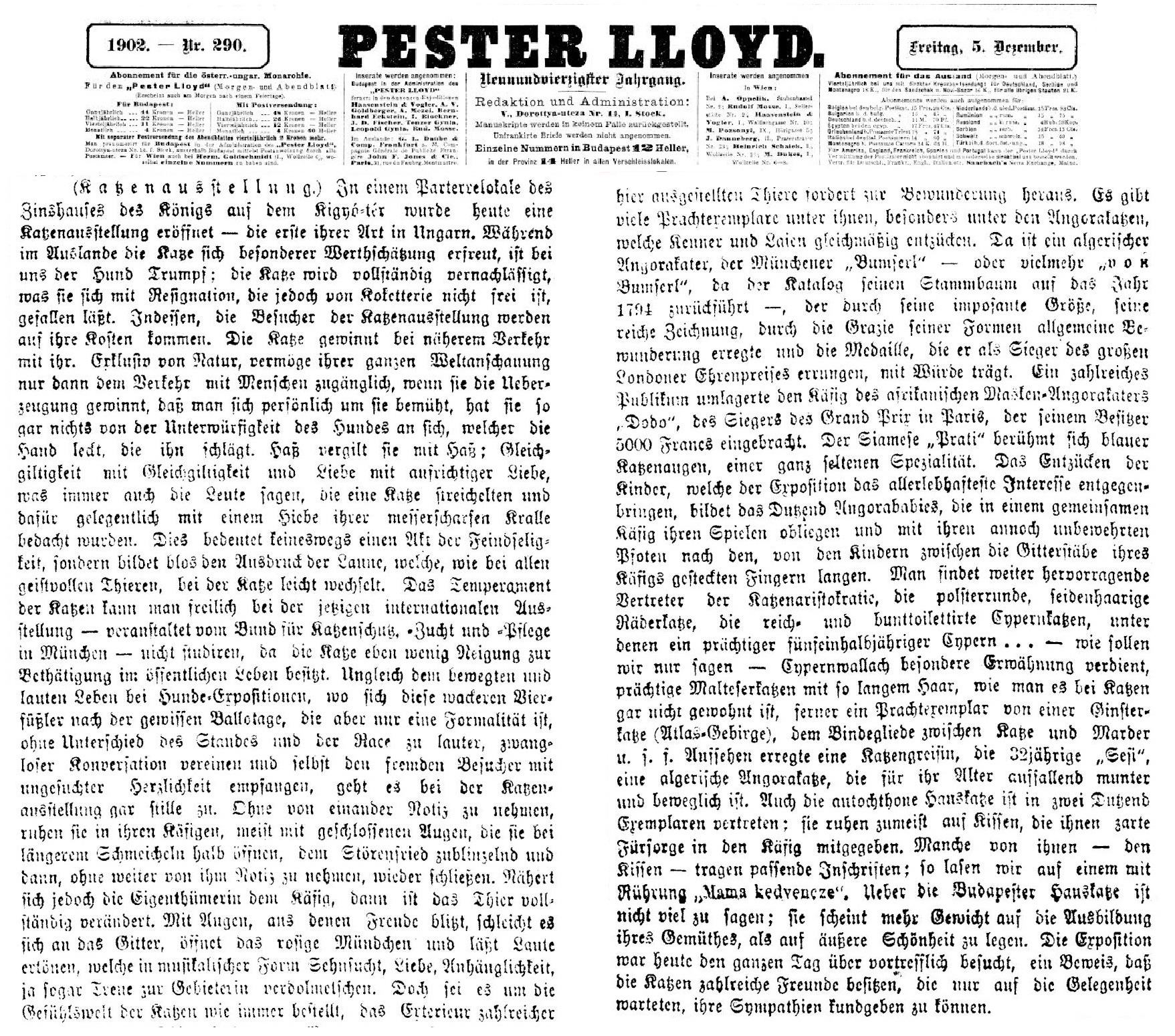
(Translation) Pester Lloyd magazine, 5th December, 1902:
“A cat exhibition – the first of its kind in Hungary – opened today in part of the ground floor of the king's apartments on Kigyo-tér. While the cat enjoys special esteem abroad, with us the dog is trumps; the cat is completely neglected, which she puts up with resignation, which, however, is not free from coquetry. Meanwhile, visitors to the cat show will get their money's worth. The cat wins when you get close to her. Exclusive by nature, by virtue of her whole world view only open to converse with people when convinced that they care about her personally, she has none of the subservience of the dog that licks the hand that beats him. She repays hate with hate; Indifference with indifference and love with sincere love, whatever the people say who stroke a cat and get the occasional swipe from their razor-sharp claws. This in no way signifies an act of hostility, but is merely an the expression of mood, which, as with all intelligent animals, easily changes in the cat. Of course, the temperament of the cats cannot be studied at the current international exhibition - organized by the Federation for Cat Protection, Breeding and Care in Munich - because the cat has so little tendency to be active in public life.
Unlike the crowded and noisy life at dog exhibitions, where these active quadrupeds unite after some ballotage, which is only a formality, without distinction of status or race, for loud, informal conversation, and even meet visiting strangers with unsought warmth, it is really quiet at the cat show. Without taking any notice of each other, they rest in their cages, mostly with their eyes closed, which they half open when they are coax for a long time, wink at the troublemaker and then close them again without taking any further notice of him. But when the owner approaches the cage, the animal is completely changed. With eyes that gleam with joy, it sidles up to the bars, opens its rosy little mouth and lets out sounds which in musical form translate as longing, love, devotion, even fidelity to their mistress. But be this as it may in the world of cats, it is the external appearance of numerous animals exhibited here that calls for admiration.
There are many fine specimens among them, especially among Angora cats, which delight connoisseurs and laypeople alike. There is an Algerian Angora cat, the Munich cat "Bumserl" - or rather "vom Bumserl", since the catalogue traces his pedigree back to 1794 - who aroused general admiration for his imposing size, his rich markings, and the gracefulness of his forms; he wears with dignity the medal he gained as winner of the grand London prize of honour. A large crowd surrounded the cage of the African masked angora cat “Dodo”, winner of the Paris Grand Prix, which brought 5000 francs to its owner. The Siamese cat "Prati", famous for its blue cat eyes, is a very rare specialty.
The delight of the children, who take a most lively interest in the exhibition, is created by the dozen Angora babies who play in a common cage and reach out with their still unarmoured paws for the fingers that the children poke between the bars of their cage. One also finds outstanding representatives of feline aristocracy, the well-padded, silky-haired classic tabbies, the rich and colourfully dressed Cyprus [mackerel tabby] cats, among which a magnificent five and a half year old Cyprus . . . – what should we call it - Cyprus gelding deserves special mention, magnificent Maltese cats with such long hair, as we are not used to with cats, also a magnificent specimen of genet cat (Atlas Mountains), the link between cat and marten, etc. The appearance of an old cat, 32-year-old “Sefi”, an Algerian Angora cat, remarkably lively and agile for her age, attracted attention. The aboriginal domestic cat is represented by two dozen specimens; they mostly rest on cushions place in the cage with tender care. Some of these cushions bear appropriate inscriptions; so I read with emotion “Mama kedvencze” [mother’s favourite]. Not much can be said about the Budapest domestic cat; she seems to attach more importance to the development of her mind than to outward beauty. The exhibition was well attended all day today, proof that the cats have numerous friends who were just waiting for the opportunity to show their appreciation.
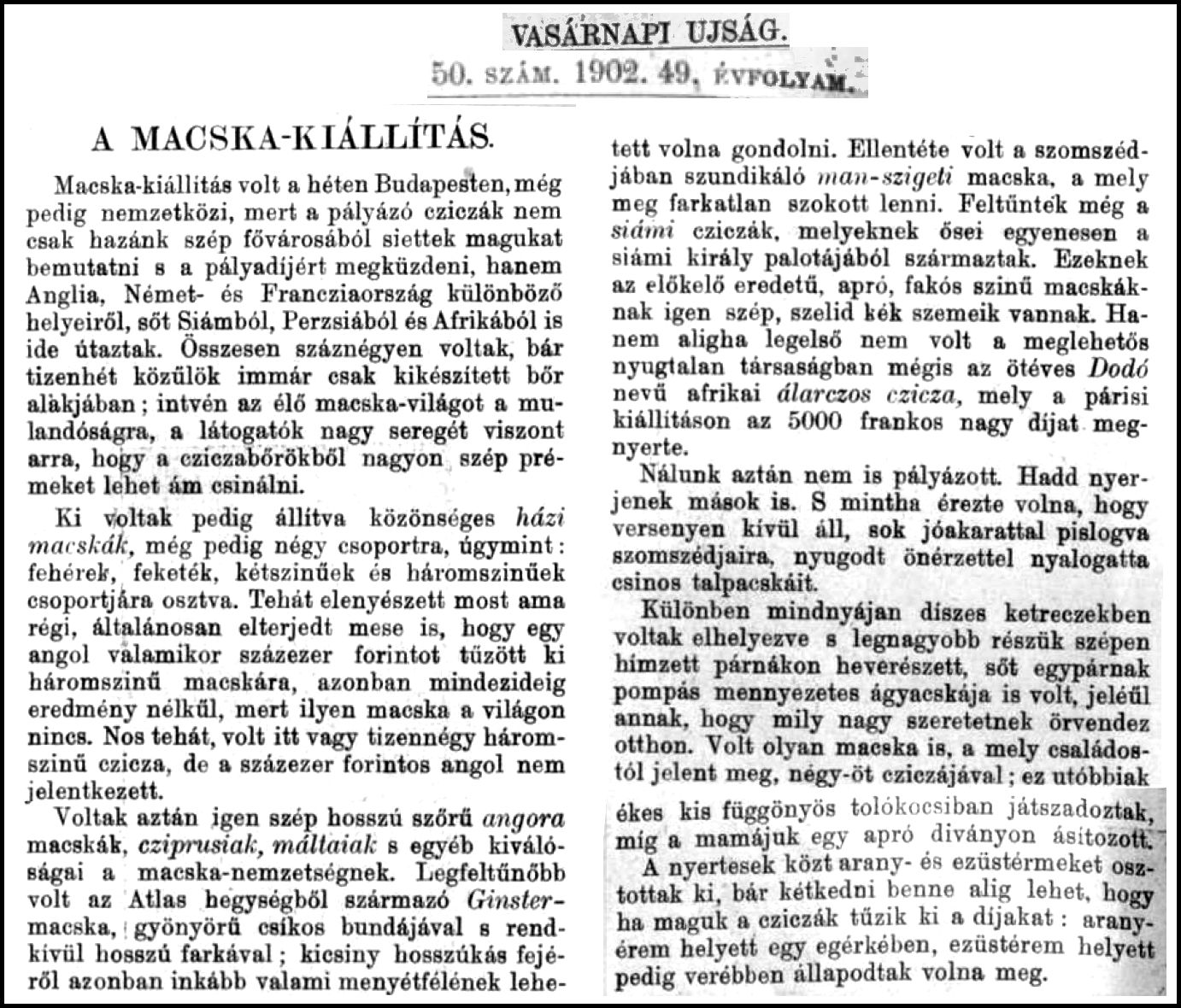
Vasarnapi Ujsag (Sunday Mail), December 14, 1902.
THE CAT EXHIBITION. There was a cat exhibition in Budapest this week, and an international one, because the competing cats came not only from the beautiful capital of our country to present themselves and fight for the prize, but also traveled here from various places in England, Germany and France, and even from Siam, Persia and Africa. There were one hundred and four of them in all, although seventeen of them were now only in the form of finished skins; warning the living world of cats about their impermanence, and the large army of visitors about the fact that you can make very beautiful furs from the skins of the cats.
Ordinary domestic cats were exhibited, divided into four groups, such as: white, black, two-coloured, and three-coloured. So the old, generally widespread tale that an Englishman once staked a hundred thousand forints on a three-colored tomcat has now disappeared, but so far without success, because there is no such cat in the world. Well, there were about fourteen three-color cats here, but the hundred-thousand-forint English one didn't show up.
There were also very beautiful long-haired Angora cats, Cypriots, Maltese and other excellent specimens of the cat family. Most notable was the Genet cat from the Atlas Mountains: with its beautiful striped fur and extremely long tails; however, his small, elongated head could have been thought of as something of a weasel. He was the opposite of the dozing Isle of Man cat next door, which usually has no tail. Siamese cats also appeared, whose ancestors came directly from the Siamese king's palace. These small, pale-colored cats of noble origin have very beautiful, gentle blue eyes. However, the five-year-old African masked cat named Dodo, who won the grand prize of 5,000 francs at the Paris exhibition, was hardly the foremost of the rather restless group. He didn't even apply for us. Let others win too. And as if he felt that he was out of the competition, he winked at his neighbours with a lot of good will and licked his pretty soles with a calm sense of self.
Otherwise, they were all placed in decorative cages and most of them were lying on beautifully embroidered pillows, and a couple even had a magnificent bed with a canopy, a sign of how much love they enjoy at home. There was also a cat that appeared from a family with four or five kittens; the latter – played in a pushcart with an ornate little curtain, while their mother yawned on a tiny couch.
Gold and silver medals were distributed among the winners, although there can hardly be any doubt that if it were the cats themselves who had chosen the awards: they would have agreed on a mouse instead of a gold medal, and a sparrow instead of a silver medal.
